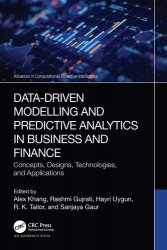Data-Driven Modelling and Predictive Analytics in Business and Finance
- Добавил: literator
- Дата: 19-05-2024, 15:31
- Комментариев: 0
 Название: Data-Driven Modelling and Predictive Analytics in Business and Finance
Название: Data-Driven Modelling and Predictive Analytics in Business and FinanceАвтор: Alex Khang, Rashmi Gujrati, Hayri Uygun, R.K. Tailor, Sanjaya Singh Gaur
Издательство: CRC Press
Серия: Advances in Computational Collective Intelligence
Год: 2025
Страниц: 443
Язык: английский
Формат: pdf (true)
Размер: 18.9 MB
Data-driven and AI-aided applications are next-generation technologies that can be used to visualize and realize intelligent transactions in finance, banking, and business. These transactions will be enabled by powerful data-driven solutions, IoT technologies, AI-aided techniques, data analytics, and visualization tools. To implement these solutions, frameworks will be needed to support human control of intelligent computing and modern business systems. The power and consistency of data-driven competencies are a critical challenge, and so is developing explainable AI (XAI) to make data-driven transactions transparent.
Data analytics is the process of examining, cleaning, transforming and interpreting data to uncover meaningful patterns, trends and insights. It involves the use of statistical and computational techniques to analyze data and extract valuable information. Data analytics can be categorized into four main types: descriptive analytics, diagnostic analytics, predictive analytics, and prescriptive analytics.
The commonly used tools and applications in data analytics include the following:
• Excel: Microsoft Excel is a widely used tool for data analysis due to its user-friendly interface and familiar spreadsheet format. It offers basic statistical functions, data sorting and filtering, and the ability to create charts and pivot tables.
• SQL: Structured Query Language (SQL) is essential for working with databases. SQL allows you to extract, manipulate, and analyze data from relational databases using queries. It is a fundamental skill for data analysts working with structured data.
• Python: Python is a versatile programming language commonly used in data analytics. It offers numerous libraries and frameworks for data manipulation (e.g., Pandas), numerical computation (e.g., NumPy), and data visualization (e.g., Matplotlib and Seaborn). Python also has powerful Machine Learning libraries such as Scikit-learn and TensorFlow.
• R: R is a programming language specifically designed for statistical computing and graphics. It provides a wide range of packages and libraries for data manipulation, visualization, and statistical analysis. R is popular among statisticians and data scientists for its extensive statistical capabilities.
• Tableau: Tableau is a powerful data visualization tool that allows users to create interactive and visually appealing dashboards and reports. It simplifies the process of creating charts, graphs, and maps, making it easier to communicate data insights effectively.
• Power BI: Power BI, developed by Microsoft, is another popular data visualization tool. It enables users to connect to various data sources, transform and model the data, and create interactive visualizations and reports. Power BI offers a user-friendly interface and is widely used for business intelligence purposes.
• Apache Hadoop: Hadoop is a framework designed for distributed storage and processing of large datasets. It consists of the Hadoop Distributed File System (HDFS) for data storage and the MapReduce programming model for distributed data processing. Hadoop is commonly used for big data analytics, enabling the processing of massive volumes of data across a cluster of computers.
• Apache Spark: Spark is an open-source, cluster computing framework that provides high-speed data processing and analytics. It supports real-time streaming, Machine Learning, graph processing, and more. Spark offers APIs in various languages, including Java, Scala, and Python, making it versatile for different data processing tasks.
Data-Driven Modelling and Predictive Analytics in Business and Finance covers the need for intelligent business solutions and applications. Explaining how business applications use algorithms and models to bring out the desired results, the book covers:
Data-driven modelling
Predictive analytics
Data analytics and visualization tools
AI-aided applications
Cybersecurity techniques
Cloud computing
IoT-enabled systems for developing smart financial systems
This book targets a mixed audience of business analysts, financial analysts, scholars, researchers, academics, professionals, and students from different commu- nities to share and contribute new ideas, methodologies, technologies, approaches, models, frameworks, theories, and practices to resolve the challenging issues associated with the leveraging of combating the six fields of data-driven modelling, predictive analytics, data analytics and visualization tools, AI-aided applications, cybersecurity techniques, cloud computing, and IoT-enabled systems for developing a smart financial systems in the era of Industrial Revolution 4.0.
Скачать Data-Driven Modelling and Predictive Analytics in Business and Finance
Внимание
Уважаемый посетитель, Вы зашли на сайт как незарегистрированный пользователь.
Мы рекомендуем Вам зарегистрироваться либо войти на сайт под своим именем.
Уважаемый посетитель, Вы зашли на сайт как незарегистрированный пользователь.
Мы рекомендуем Вам зарегистрироваться либо войти на сайт под своим именем.
Информация
Посетители, находящиеся в группе Гости, не могут оставлять комментарии к данной публикации.
Посетители, находящиеся в группе Гости, не могут оставлять комментарии к данной публикации.
